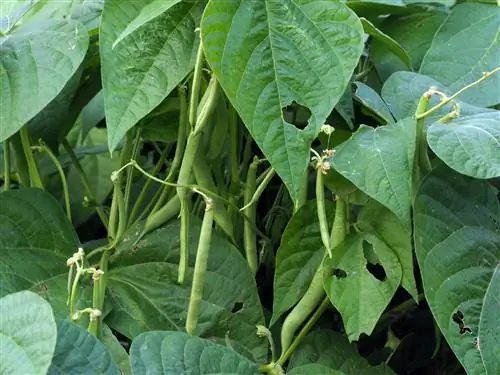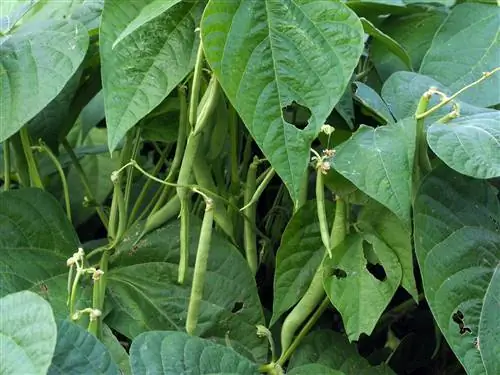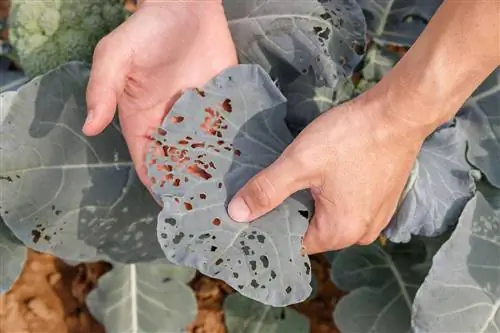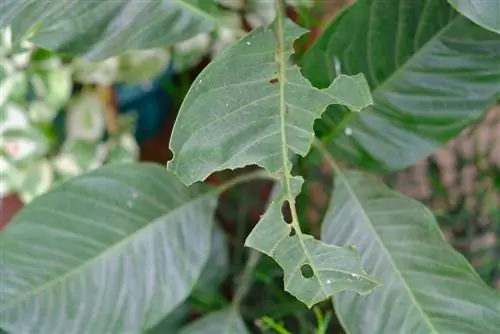- Author admin [email protected].
- Public 2023-12-16 16:46.
- Last modified 2025-01-23 11:19.
Planted recently, they still looked phenomenally he althy and in perfect shape. But now there are signs of damage here and there on the leaves of the bush beans that have been raised with love. Follow in the footsteps of the perpetrators of this

What's behind eaten leaves on bush beans?
As a rule, the so-calledbean flyis the cause behind eaten leaves on bush beans. Their maggots prefer to eat the cotyledons and stems. In addition,snailsandcutworms can also be behind the feeding marks on the bush bean leaves.
How do I recognize a bean fly infestation on the bush bean?
Eaten cotyledonsandStems can be an indication of an infestation by bean fly maggots. The bean fly itself resembles a common housefly. It grows to around 4 to 6 mm in size and the white maggots hatch from the eggs it lays. The bean flies like to lay their eggs on bean seeds and seedlings usually between April and May - exactly at the time when bush beans are sown or planted in the garden.
How can the bean fly be eliminated from the bush bean?
If you want to curb the problem, you could tryNeem. To do this, simply add some neem oil to the water. This oil deters all pests. Otherwise, there areno special products that specifically combat the bean fly on bush beans.
Can bean fly infestations on French beans be prevented?
In order to prevent the leaves from being eaten by the bean fly on the bush bean, amixed culture is recommended. To do this, simply plant plants between the bush beans whose smell the bean fly doesn't like. These include, among others:
- Onions
- Tomatoes
- garlic
- Dill
- Chamomile
- Savory
In addition to mixed culture, the following points help to prevent the bean fly:
- don’t fertilize too much
- Loosen the soil well before planting
- Observe crop rotation (do not plant bush beans after cabbage, potatoes, spinach and legumes)
- flat sowing
- do not sow in cool weather
- Sowing time: from mid-May
- Place fleece over the sown beans
- Prefer beans in pots
How can snails prevent damage to the bush bean?
To prevent snails from eating marks on the leaves of the bush beans, it is advisable to sprinkleslug pelletsor to prefer the beans at home, until they are large and resilient enough. It also often helps to mulch the bush beans.
What other pests eat the leaves of bush beans?
In addition to snails and the bean fly,aphidsorcutworms are sometimes the cause behind eaten leaves on the bush bean. Aphids are usually found on the underside of leaves. They are particularly attracted to weakened bush beans. For example, plants are weakened if they have been fertilized too heavily. Cutworms grow significantly larger than aphids and come out, especially at night, to feed on the bean leaves. Nematodes help to combat this.
Tip
Pay attention to crop rotation after a bean fly infestation
If your bush beans were infested with the bean fly or its maggots, you should not cultivate any plants such as spinach, peas, onions, asparagus and lettuce on the site. The bean fly would then also attack these plants.






